The Bavarian State Painting Collection has a painting from the late 17th century that just begs the question of where the artist got the inspiration for his work. The prolific Flemish artist David Teniers the Younger (1610-1690) was a contributor to the genre of the ‘monkey scene’ or ‘singerie’ where monkeys were given human attire and placed in familiar environments. We’re familiar with 17th-century Dutch paintings showing families at home or people drinking in bars. When the people are removed and monkeys substituted, however, the humour changes. We no longer have a record of a time and a place but rather a commentary on all the silly things we do – the folly of the world.
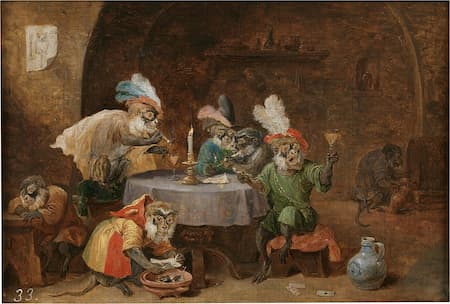
David Teniers II: Smoking and Drinking Monkeys, c. 1660 (Prado)
Bohuslav Martinů: Bajky (Fables), H. 138 – No. 3. Opicky (The Monkeys) (Giorgio Koukl, piano)
From the left, a monkey is sleeping off his day, another is pulling paper out of a bowl, three monkeys are working with their pipes, and one with a feathered cap is singing, inspired by his drink. At the back a serving monkey brings them another serving of wine. The floor is scattered with cards. On the wall is a picture of the wise owl.
In another painting he shows monkeys encamped in a town. The monkeys sit in military tents and are well supplied with food and drink. One monkey, finely dressed in a pearl necklace, runs a butcher shop to supply the camp wand another draws a beaker of wine from a cask. In the background, one monkey plays a drum while another plays a trumpet, perhaps to get locals to sign up for the army. Again, the wise owl is shown over the tent door.
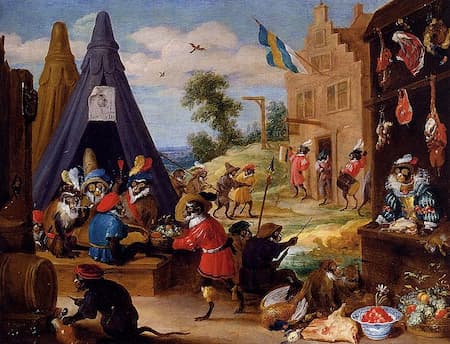
David Teniers II: A Monkey Encampment, 1633 (private collection)
Alexander Lazarevich Lokshin: In the Jungle – III. Games of the Monkeys (Recreation – Graz Grosses Orchester; Michel Swierczewski, cond.)
The French painter Antoine Watteau, better known for his paintings of commedia dell’arte figures, also made a singerie: The Monkey Sculptor. Painted in his rococo style, Watteau has given us a monkey artist of great seriousness, with a statue that can’t bear to look at him. If humans do figurative sculpture to show the beauty of the human body, what can a monkey be doing?
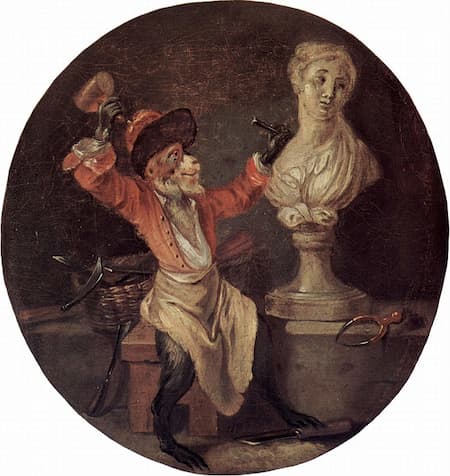
Watteau: The Monkey Sculptor, ca. 1710 (Musée des Beaux-Arts d’Orléans, Orleans, France)
Jonathan Dove: A Brief History of Creation – XII. Monkeys (Hallé Children’s Choir; Hallé Orchestra; Mark Elder, cond.)
David Teniers II’s brother Abraham also contributed to the singerie genre with his monkeys and cats in a barbershop scene. The monkeys are the barbers, and the cats are the customers, having their whiskers curled, or their beards shaved.
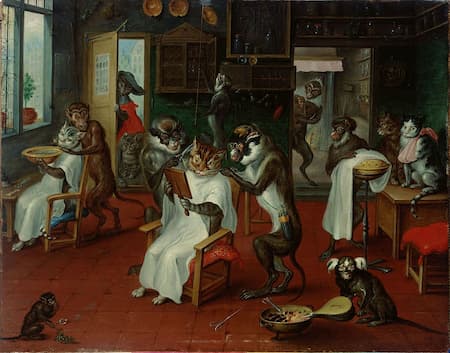
Abraham Teniers (1629-1670): Barbershop with Monkeys and Cats, 2nd third of the 17th century (Kunsthistorisches Museum Wien, Gemäldegalerie)
Igor Stravinsky: Berceuses du Chat for Mezzo-Soprano – The Cat Has… (Ingrid Silveus, mezzo-soprano; Schirmer Ensemble; Kelly, Brett cond.)
If we return to David Teniers II, we find a painting that moves the monkey to the edge and pulls the cats forward to the centre of the scene. 3 cats and 2 kittens are gathered around a music book, while another cat looks in the window on the left. On the floor, are two monkeys in bright clothing. One plays a shawm while the other looks on. On the floor on the right are a bagpipe, a lute, a lute case, and another woodwind. On the floor is a partbook of music. On the backwall on the left a dancing-masters kit violin hangs on the wall. Seated on the cats’ book is the same owl we’ve seen drawn in other of David Teniers II’s monkey pictures.
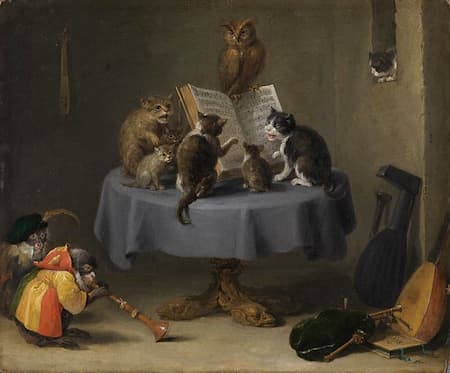
David Teniers II: The Concert of Cats, 1650 (Bayerische Staatsgemäldesammlungen – Staatsgalerie Neuburg)
Maurice Ravel: L’enfant et les sortileges – Musical duet of mewings (The White Cat, The Black Cat) (Kirsten Gunlogson, White Cat; Ian Greenlaw, Black Cat; Nashville Symphony Orchestra; Alastair Willis, cond.)
Meeeeow.
For more of the best in classical music, sign up to our E-Newsletter




